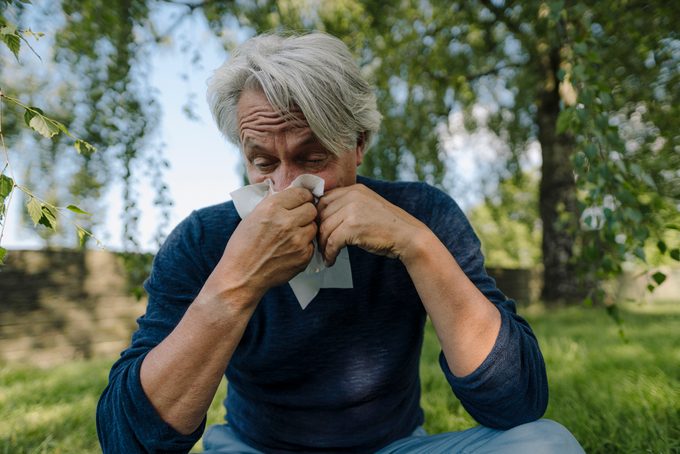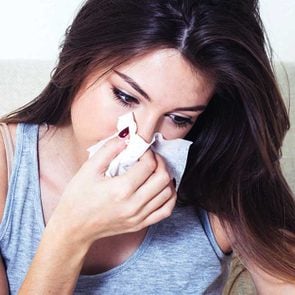What to Know About Hay Fever Symptoms, Causes, and Treatments
Updated: Jul. 21, 2021
Everything you need to know about hay fever (allergic rhinitis), from when and why allergies happen to the best ways to relieve your symptoms.
On This Page
What is hay fever?
Allergy season usually kicks off in early spring, as trees start producing pollen. The process sets millions of Americans up for months of discomfort.
Pollen exposure triggers various allergic reactions, including symptoms of hay fever, also known as allergic rhinitis.
“Hay fever is another term for seasonal allergies, also sometimes referred to as allergic rhinitis,” explains Stephanie Leeds, MD, an allergist and immunologist with Yale Medicine and assistant professor of pediatrics at Yale School of Medicine.
Allergic rhinitis affects children and adults, and it can affect both physical health and quality of life.
“Allergic rhinitis is very common and affects somewhere between 10 to 30 percent of people in the United States,” she says.
The Centers for Disease Control and Prevention (CDC) estimates that close to 60 million Americans deal with hay fever, and that number will likely increase in the coming years.
Hay fever, first described about 200 years ago, is a term that has been used because symptoms can correspond to the haying season, which is in the summer.
However, keep in mind that hay fever generally doesn’t cause an actual fever, you don’t need to be exposed to hay to have it, and it can occur at any time of the year—it depends on what allergens trigger your allergic rhinitis symptoms.
Pollen is not the only cause of allergic rhinitis, but higher pollen concentrations and longer pollen seasons—results of climate change—may cause more people to feel the health effects of pollen and other allergens, the CDC says.
Here’s what you need to know about the basics of hay fever, including the symptoms, causes, and treatments.
Hay fever causes
Hay fever occurs when allergens, like pollen or mold spores, enter your body and your immune system mistakenly identifies them as threats.
“The immune system develops a specific antibody [IgE] to allergens in the environment,” Dr. Leeds says. “So for someone who has a tree pollen allergy, the allergy cells in the nose, eyes, and skin have tree IgE antibodies that are sitting on the surface. Once there is an exposure, the allergens bind to these IgE antibodies and cause the allergy cells to release preformed mediators, like histamine, which cause clinical symptoms.”
Persistent symptoms that last more than four consecutive weeks indicate chronic rhinitis. Meanwhile, acute rhinitis only lasts a few days—four weeks max.
(Is the loss of smell seasonal allergies or Covid-19?)
Seasonal allergic rhinitis
Pollen, an airborne allergen, is most often responsible for the development of hay fever, according to the CDC. Flowering plants, trees, grasses, and weeds disperse tiny pollen particles that are key to their reproductive cycle.
The amount and type of pollen both depend on the season and geographical area, although pollen counts are typically higher during the warmer seasons, when trees, plants, and grasses are pollinating.
Dr. Leeds explains that the biggest triggers are weeds in the fall, trees in the spring, and grasses in the summer. People in most climates don’t deal with the condition during the winter months.
Perennial allergic rhinitis
Hay fever may also be perennial, or yearlong, especially if the trigger isn’t seasonal like pollen.
“For people who have allergic symptoms that are year-round, common triggers include dust mites, animals, and molds,” she adds.
These are some allergens that may cause yearlong hay fever symptoms:
- mold
- pet fur or dander
- dust mites
- cockroaches
Some people experience similar symptoms from irritants, such as smoke, perfumes, or pollutants.
Who is at risk?
While people of all ages experience hay fever, some are more likely to develop allergies than others.
People with respiratory illnesses, including asthma, may be more sensitive to pollen. Pollen exposure is associated with asthma attacks and increases in hospital admissions for respiratory illness.
The connection between asthma and allergies is so strong that there’s a condition known as allergic asthma.
Dr. Leeds adds that other potential risk factors for developing allergic rhinitis include a family history of allergies, being born during pollen season, early use of antibiotics, and maternal smoking exposure in the first year of life.
(Avoid these allergy myths for faster relief.)

Hay fever symptoms
According to Dr. Leeds, the most common symptoms of hay fever are:
- sneezing
- runny nose
- itchy nose
- congestion
- red eyes
- watery eyes
- itchy eyes
How is hay fever diagnosed?
A specialist generally diagnoses hay fever.
“An allergist will often diagnose allergic rhinitis with either a skin prick test or blood test,” explains Dr. Leeds.
If you believe you have hay fever, contact your doctor immediately. “Allergists can help identify triggers and develop individualized treatment plans,” she says.
Hay fever treatments
There are several allergic rhinitis treatments, according to the American College of Allergy, Asthma, and Immunology (ACAAI). They include the following medication and lifestyle changes.
Avoidance
The first approach should be to try to avoid the allergens that trigger symptoms.
Avoidance solutions for seasonal allergies may include staying indoors during times of the day when pollen counts are peaking, usually mid-morning and early evening, or when winds are blowing.
When outdoors, avoid rubbing your eyes, and wear protective eyewear or a face mask to prevent pollen from getting into your eyes or airways.
When indoors, try to keep windows closed as much as possible to avoid pollen from entering the house, take showers to wash pollen off your hair and body, or try some of these other doctor-approved methods of allergy-proofing your home.
Medications
Because pollen is airborne, you can’t avoid it altogether.
There are various medications, including oral tablets, liquid medications, nasal sprays, and eye drops, that can help treat hay fever symptoms.
Intranasal corticosteroid
The most effective drug for treating hay fever is an intranasal corticosteroid, once-daily nasal sprays that can reduce nasal congestion, sneezing, itching, and a runny nose. Brand names include Nasacort Allergy 24HR, the first over-the-counter intranasal corticosteroid to become available, and Flonase Allergy Relief, the second.
Antihistamines
Antihistamines are a common allergic rhinitis treatment. These medications counter the effects of histamine, the irritating chemical released by your body during an allergic reaction that’s responsible for the symptoms.
People can take antihistamines in eye drops, nasal sprays, and, most commonly, oral tablets and syrups. They are available both by prescription and over the counter.
Some people find that this treatment method becomes less effective over time and may cause side effects such as drowsiness or performance impairment and excessive dryness of the mouth, nose, and eyes.
Decongestants
Decongestants, sold by prescription and over the counter, are another treatment method, helping to relieve the stuffiness and pressure caused by swollen nasal tissue.
The major pro is that there are none of the related side effects because they do not contain antihistamines. However, congestion is the only symptom they relieve.
Nonprescription decongestant nasal sprays work within minutes and last for hours, but the ACAAI warns not to use them for more than a few days at a time, unless instructed by your allergist.
Prolonged use can cause rhinitis medicamentosa, or rebound swelling of the nasal tissue, leading to more frequent congestion and requiring medication more frequently than recommended.
Nonprescription saline nasal sprays
Nonprescription saline nasal sprays are another treatment option.
These help by counteracting symptoms, including dry nasal passages or thick nasal mucus. A saline nasal spray can be used as often as it is needed.
Nasal rinses
Some allergists recommend washing the nasal passage via a saline rinse. You can do this by using a saline nasal spray, a neti pot, or a saline rinse bottle.
Immunotherapy
Immunotherapy, in the form of allergy shots and sublingual (under-the-tongue) treatments, is another option for those who don’t respond well to other medications or who deal with severe side effects.
The treatment essentially trains your immune system, by gradually increasing the dose of allergen, to not react to the allergen.
Other hay fever treatments
Additional drugs for treating allergic rhinitis include:
- Nasal cromolyn (Nasalcrom)
- Nasal ipratropium bromide spray (Atrovent)
- Intranasal antihistamine
- Leukotriene pathway inhibitors (montelukast, zafirlukast, and zileuton)
The latter is a group of prescription drugs that block the action of leukotriene, a substance in the body that can cause symptoms of allergic rhinitis.
Next, check out expert tips for staying allergy-free all summer.


















